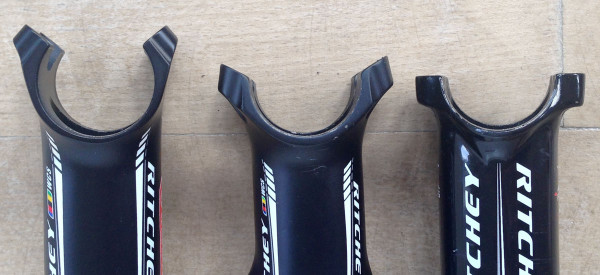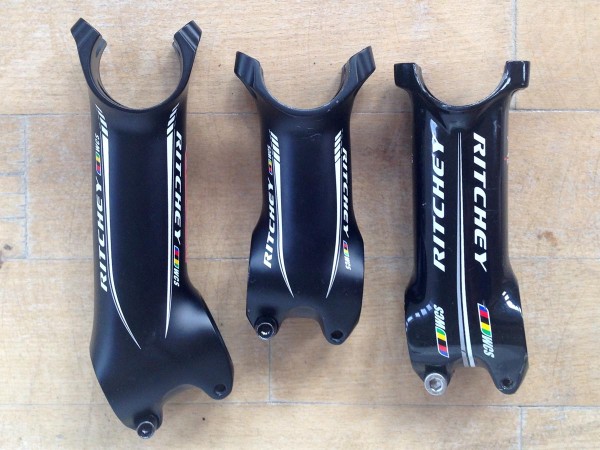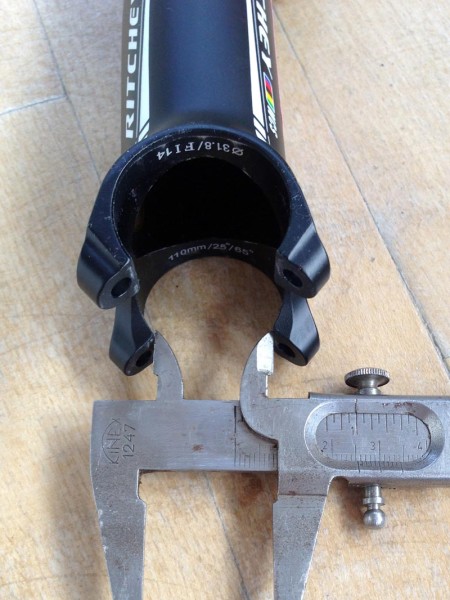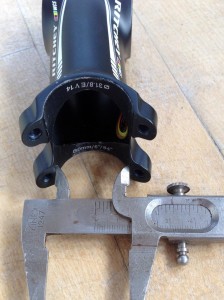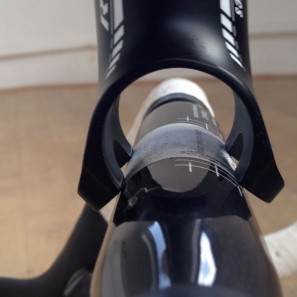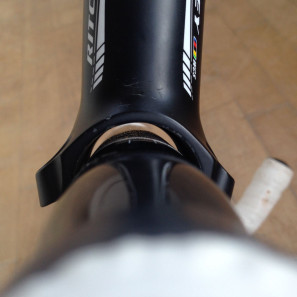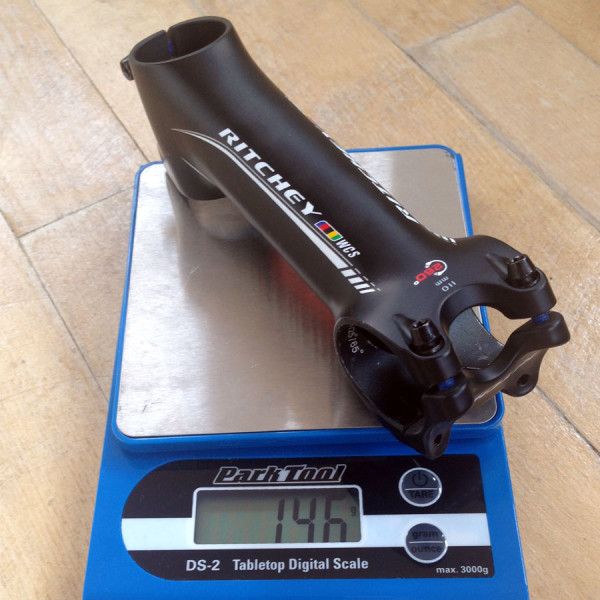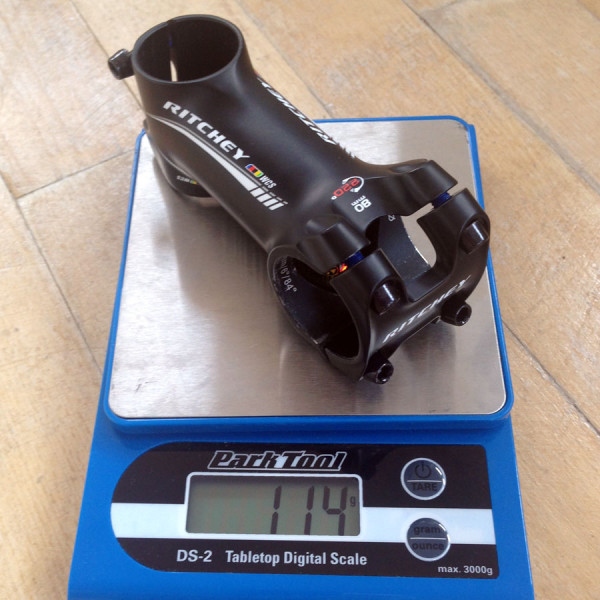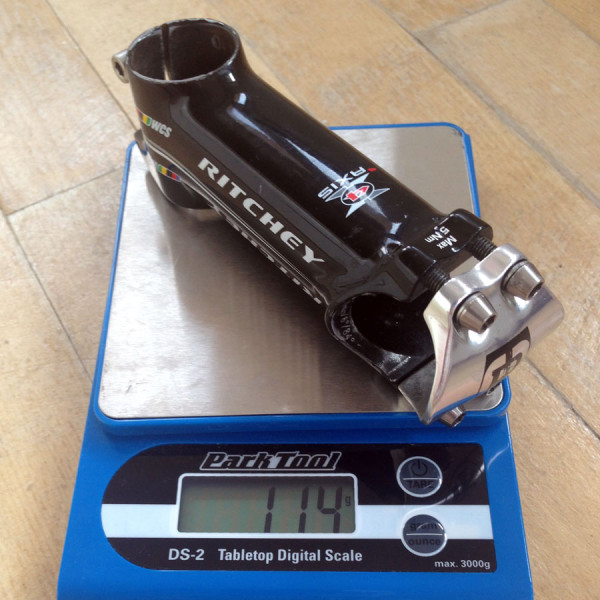At Eurobike and Interbike last fall we got a first glance at some new stems from Ritchey but wanted a deeper look. Their range of stems now includes three variations on how much the stem body wraps around the 31.8mm clamping surface of your handlebar. The thinking goes that the more the wrap, the smaller the faceplate needs to be, the lighter the faceplate bolts can be, all while creating a stem/bar interface that is lighter and stronger. The only problem is that more wrap creates some mounting complications. To test out how user-friendly each stem was and how they worked on various bars, Ritchey let us try one of each: the 180° wrap carry over 4-Axis stem, the 260° wrap C260 that was brought to market back in 2012, and a newly introduced 220° wrap C220.
Follow past the break to see what our experience has been and how we’ll likely use each type…
I’ve long felt that the standard 2014 alloy aluminum Ritchey 4-Axis WCS stem was a great multi-use stem, as it balanced low weight, affordability, and performance quite well. It has essentially been my go to stem for small fit adjustments on road, cyclocross, and XC mountain test bikes for years. The only issue I’d really ever had were with some of the early 4mm ti bolts, so I was curious about the switch to torx bolts on some of the new stems. While strength was never really a problem, a little extra stiffness could always be good, especially for wider mountain bars. And with the advent of the new 2014 alloy C220 stems, the 4-Axis is being phased out at the WCS level. Stock still seems readily available, but as of model year 2015 the 4-Axis will only be a comp-level 6061 alloy item.
We had been a little reluctant (as apparently some readers seem to have been as well) about the development of the newer C260 which wraps 260° (almost a full 3/4s of the way) around the bar. The idea of a more secure grip on the bar seemed good, but the complication of getting a wrapped road bar or any shaped bar into that clamp seemed daunting. Even just squeezing the 31.8mm section of a mountain bar in looked like it could be difficult (which in reality we found it was not an issue.) Well, to address the issue Ritchey developed the new C220 which as expected wraps 220° around the bar. By splitting the difference between the C260 and 4-Axis, the new C220 becomes a lot more versatile and still keeps the better retention and stiffness.
To look at usability of the stems, first we measured the stem body/face plate opening on each to get a sense of how much space would be available to install different bars. Next, we measured the dimensions of several handlebars representing typical bars, which we already had mounted on bikes, 7.5 & 10cm (3&4”) from the center of the clamping surface. (We measured at 7.5cm, because this was about the farthest distance any of our bars had the tape wrapped, and by 10cm most bars had transitioned to their final top dimension.) Then we tried each stem on the tapered low-rise mountain bar, the gradual-taper aluminum road bar, the abruptly-tapered round carbon road bar, and Ritchey’s own Evocurve shaped-top carbon road bar.
Stem body/face plate openings:
C260 – 25.3mm
C220 – 31.4mm
4-Axis – 31.8mm
Handlebar dimensions 8/10cm from the clamp:
Low-ride mountain- 27/24.5mm
Aluminum road – 27/24mm
Carbon road – 25/24mm
Ritchey Evocurve carbon- 31×32/34.5x29mm
As was pretty clear from the measurements we took, the C260 had the most compatibility issues. It was only possible to install it on the mountain bars and a single tapered carbon road bar without any adjustment. The aluminum bars and the other straight carbon bars were all pretty simple to install the C260 with the bar unwrapped past the first bend, but with the levers still in place. But the shaping of Ritchey’s own Evocurve bar (and previous Evolution model) made it a bit of a puzzle twisting back and forth to get the stem on even with one lever and all the tape removed. It was complicated enough that Ritchey apparently produced a video showing you how to do it. The clamp body of the stem is a little bigger than the 31.8 of the bars so it does freely slide onto all bars and then is cinched down tight when the face plate is bolted on.
The C220 was much easier to work with. Since it’s opening is just a shade smaller than the 31.8 bar clamping area, it actually kind of snaps onto the bar. That means it went on ALL of the bars WITHOUT removing anything, no twisting and trying to guide it through the bends of a bar. It only required a more careful snap into place, as once the bar was in the stem it took a bit of effort to reposition its angle.
The 4-axis of course went straight on, as well with no hassle.
Our final thought on setup?
The C260 is a stiff and reasonably light stem. Our aluminum 110mm weighed 146g, but installation is a chore. Ritchey claims about 130g for this size, so it is actually their heavier WCS option (due to the steep -25°angle) and our sample was again heavier than expected. If you are building a new bike or at least upgrading the stem with the bar, it makes for a nice secure interface. We struggled a bit to get it on the Evocurve which isn’t really an overly shaped bar. Be careful if you are picking out a handlebar with a truly flat top, as it very possibly will not be compatible with the C260.
Update: As I note in the comments, the weight of this -25° C260 stem should not be directly compared to the other 2 stems. The steep angle means the forging method is a bit different and the stem needs extra material to resist additional forces. In fact the layout of the steerer bolts are even different on this stem. The typical C260 stems are the lightest aluminum stems from Ritchey as a general rule.
The C220 is a good compromise with added strength vs. a traditional clamp, with our 80mm sample weighing just 114g (close to Ritchey’s 111g estimate.) It offers a lot of the stiffness and security of the C260 without most of the hassle and has traditional forward facing stem bolts for those who prefer that aesthetic. The last push or snap that you do to put the C220 in place is a bit odd at first and requires a bit more work to finely adjust bar angle, but ultimately results in a secure connection and Ritchey’s lightest aluminum stem. It makes a good upgrade, and we are OK with it gradually replacing the 4-axis as an all-around use stem.
And in case you still feel like all of that is too complicated, the 4-Axis still makes a nice simple, well-performing stem. Our 100mm sample was the lightest of the bunch also at just 114g (about 12g lighter than Ritchey estimates), although the switch to the Comp-level will probably add about 30g. You will still see them show up on a lot of our test bikes, as they make it really easy to swap back-and-forth quickly to adjust to individual test rider needs, and they do seem to last.
Note: We include weights here, like all of our posts to give our readers some real-world data. Remember we are comparing different length and angle stems here, so jump to conclusions with caution.
Btw, we appreciate your comments and interest in the topic.
Thanks, that is all.
